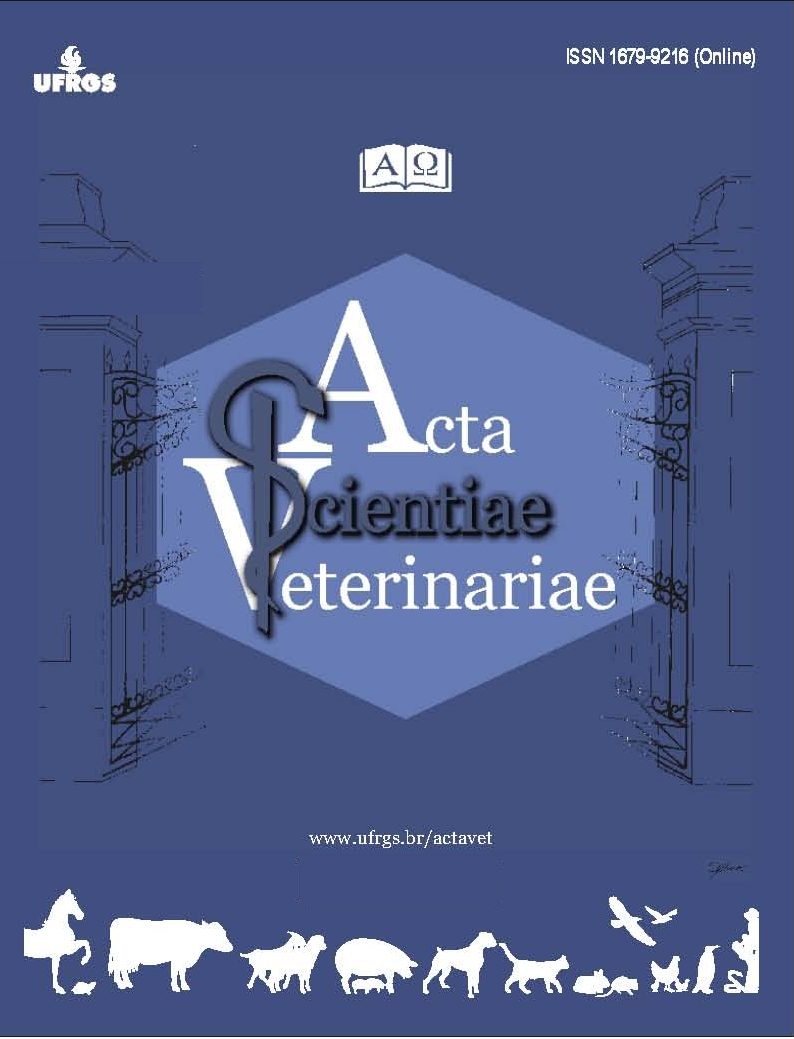Jejuno-Jejunal Intussusception in an Adult Creole Horse
DOI:
https://doi.org/10.22456/1679-9216.138043Keywords:
equine colic, exploratory laparotomy, ultrasonographyAbstract
Background: Colic syndrome is a leading cause of death in horses. Anatomical peculiarities predispose horses to morphophysiological changes. Intussusception, an important cause of colic in foals, is uncommon in adult horses. It is characterized by the invagination of an intestinal segment into an adjacent aboral segment. Small intestinal intussusception is believed to develop because of abnormal intestinal peristalsis, causing acute and progressive abdominal discomfort. Herein, we aimed to report a rare case of intussusception of the jejuno-jejunal portion of the small intestine in a 10-year-old Criollo horse.
Case: A 10-year-old Crioulo horse, weighing 400 kg, was referred to the veterinary hospital with acute colic syndrome. On the property, the horse demonstrated signs of being in intense pain. A sudden feed change without a gradual transition was reported. The horse was treated with nonsteroidal anti-inflammatory drugs to relieve the pain, and a nasogastric tube was inserted. However, he continued to demonstrate signs of being in severe pain, and his condition was not stable. Therefore, he was referred to the hospital for further management. Upon arrival, a blood test was performed, which revealed a hematocrit below the reference value and a leukogram with numerous platelet clusters. On physical examination, the horse’s heart rate, respiratory rate, and rectal temperature were within normal limits, and the mucous membranes were pale. Transabdominal ultrasound revealed thick walls in the small intestinal segment and overlapping loops. To confirm the diagnosis, an exploratory laparotomy was performed with the horse in a dorsal decubitus position and under inhalation anesthesia. On inspection, the loops of the small intestine were congested and distended, and the intussusception was identified in the middle-to-distal 3rd of the jejunum. The origin of the invagination was located, and the intussusceptum was separated from the intussuscipien. Because of the injuries caused to the mucosa by strangulation, the affected intestinal portion was excised using the technique of intestinal wall reduction, resection, and anastomosis. The colon was washed and repositioned, and celiorrhaphy was performed on the 3rd postoperative day, an abdominal ultrasound was performed. It demonstrated normal intestinal flow, indicating that the surgical intervention had effectively corrected the condition and restored intestinal function.
Discussion: The diagnosis of intussusception was established on the basis of clinical signs, ultrasound findings, and macroscopic changes observed during a laparotomy. Jejunal intussusception is uncommon in adult horses, and it is more prevalent in young animals aged 6 months to 3 years. Although intussusception is uncommon in adult animals, its incidence in this age group cannot be underestimated because it can cause serious pathologies, requiring immediate diagnosis and surgical intervention to avoid irreversible damage. Abrupt changes in the diet may be an important predisposing factor, regardless of the animal’s age. Ultrasonography is a good diagnostic tool for intussusception, which appears as a characteristic “target lesion” or “bull’s eye.” Exploratory laparotomy is the most appropriate treatment choice, allowing confirmation of the diagnosis of intussusception and effective resolution of the symptoms.
Keywords: equine colic, exploratory laparotomy, ultrasonography.
Título: Intussuscepção jejuno-jejunal em cavalo adulto da raça Crioula
Descritores: laparotomia exploratória, síndrome cólica equina, ultrassonografia.
Downloads
References
Alves K.C.G., Scarpion L.B., Paiva L.M.S. & Celiotti G. 2023. Intussuscepção em potra mangalarga - relato de caso. In: 24° Encontro Acadêmico de Produção Científica do Curso de Medicina Veterinária (São João da Boa Vista, Brazil). pp.17-20.
Doherty D., Valverde A. & Reed R.A. 2022. Farmacologia dos Agentes Usados em Anestesia de Equinos. In: Manual de Anestesia e Analgesia em Equinos. São Paulo: Roca, pp.184-222.
Feitosa F.L. 2000. Semiologia do Sistema Digestório. In: Semiologia Veterinária, a Arte do Diagnóstico. São Paulo: Roca, pp.114-197.
Laranjeira P.V.E.H., Almeida F.Q., Lopes M.A.F. & Pereira M.J.S. 2009. Síndrome cólica em equinos de uso militar: análise multivariável de fatores de risco. Ciência Rural. 39(6): 1795-1800. DOI: 10.1590/S0103-84782009000600024
Leiria P.A.T., Berlingieri M.A., Rosa G., Acosta L. & Gaschiler M. 2016. Jejunojejunal intussusception in foal: case report. Brazilian Journal of Veterinary Research and Animal Science. 53(4): 1-4. DOI: 10.11606/issn.1678-4456.bjvras.2016.90165
Matsuda K., Shimada T., Kawamura Y., Sakaguchi K., Tagami M. & Taniyama H. 2013. Jejunal intussusception associated with lymphoma in a horse. The Journal of Veterinary Medical Science. 75(9): 1253-1256. DOI: 10.1292/jvms.13-0060
Nelson B.B. & Brounts S.H. 2012. Intussusception in Horses. Compendium: Continuing Education for Veterinarians. 34(7): E4.
Reed S. M. & Bayly W.M. 2021. Afecções do sistema gastrointestinal. In: Medicina Interna Equina. São Paulo: Guanabara Koogan, pp.900-1084.
Thomassian A. 2005. Afecções do aparelho digestório. In: Enfermidade dos Cavalos. São Paulo: Livraria Varela, pp.265-408.
Additional Files
Published
How to Cite
Issue
Section
License
Copyright (c) 2025 Bárbara Tassoni Andriotti, Bruna Pioner de Jesus, Catherine Dall'Agnol Krause, Jade Paiva Del Manto, Guilherme dos Santos Meirelles, Louise Maciel Fernandes, Henrique Mondardo Cardoso, Ana Carolina Barreto Coelho

This work is licensed under a Creative Commons Attribution 4.0 International License.
This journal provides open access to all of its content on the principle that making research freely available to the public supports a greater global exchange of knowledge. Such access is associated with increased readership and increased citation of an author's work. For more information on this approach, see the Public Knowledge Project and Directory of Open Access Journals.
We define open access journals as journals that use a funding model that does not charge readers or their institutions for access. From the BOAI definition of "open access" we take the right of users to "read, download, copy, distribute, print, search, or link to the full texts of these articles" as mandatory for a journal to be included in the directory.
La Red y Portal Iberoamericano de Revistas Científicas de Veterinaria de Libre Acceso reúne a las principales publicaciones científicas editadas en España, Portugal, Latino América y otros países del ámbito latino





